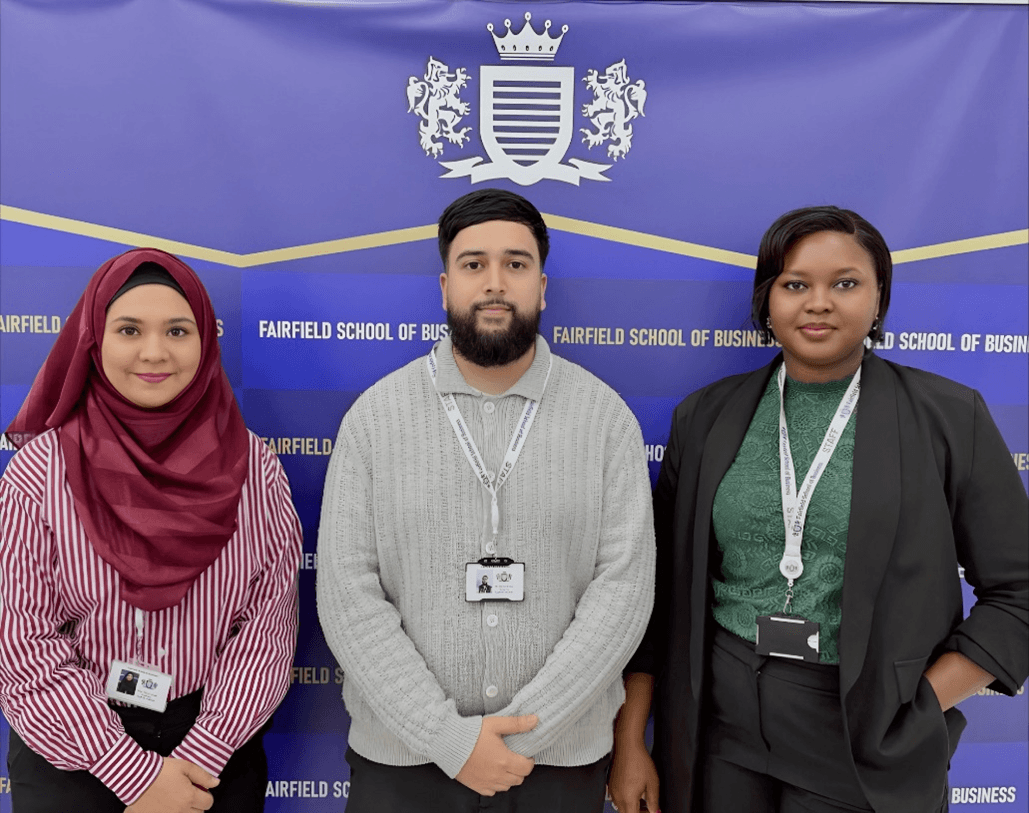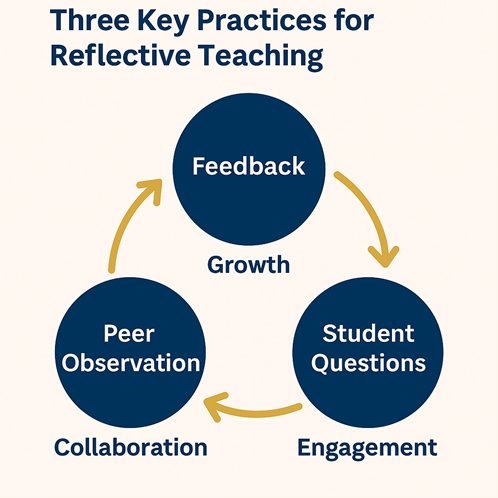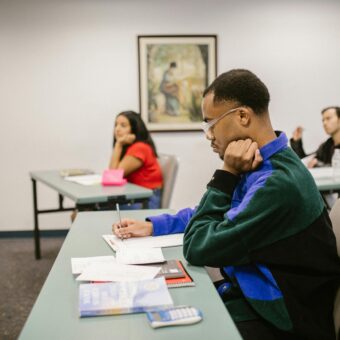
By Sher Ali Imtiaz, Mercy Oladimeji, and Maida Qutub
Lecturers in Business and Management at Fairfield School of Business, FSB Digbeth Campus | Article Date: 30/10/2025
During a recent peer observation at FSB Digbeth, one small shift changed everything. A colleague invited students to share examples from their own workplaces and families to explain a concept. The room opened up. Students leaned forward, spoke confidently, and connected theory to real situations they understood. The lecture became a conversation. We left that session inspired, reminded that learning becomes meaningful when students can see themselves in it.
Teaching with purpose means creating learning experiences that connect theory to students’ lived realities, encourage reflection, and build the confidence to apply knowledge beyond the classroom. It is about being intentional in designing lessons that inspire understanding, growth, and curiosity in every learner (Brookfield, 2017).
Teaching with purpose also means recognising that every student’s journey is different. Many of our FSB learners balance study with work, family, and community commitments. Purposeful teaching considers these contexts and adapts learning so that it feels relevant, inclusive, and achievable. When students can link academic theory to their real-world experiences, learning becomes more authentic and lasting.
For us, teaching with purpose is also about reflection, not just for students, but for lecturers too. Each lesson offers an opportunity to refine our approach, ask what worked well, and identify what could be improved. This continuous process of reflection ensures that our teaching remains responsive and meaningful.
Purposeful teaching at FSB is therefore built on three key elements:
1. Feedback that guides growth,
2. Peer observation that encourages shared learning, and
3. Student questions that shape our lessons.
Together, these create a learning environment that values curiosity, confidence, and collaboration – the foundations of lifelong learning.
In this article, we explore three key practices that shape learning in our classrooms:
1. Cultivating growth through feedback
2. Learning collaboratively through peer observation
3. Shaping lessons through student questions
At FSB, teaching is more than delivering lectures or marking assignments. It is about connection, encouragement, and helping every student build the confidence to succeed. As Lecturers, we come from different teaching areas, but we share one belief: education should be inclusive, practical, and transformative. Together, we reflect on how we help our students grow and how we continue to grow as teachers.
Teaching is special because it centres on people. We work with students from many different backgrounds and experiences, and we take pride in creating a learning environment where everyone feels supported and valued. Our lessons focus on real-world learning, helping students connect academic knowledge to professional practice.
FSB’s mission reminds us that education should be accessible and relevant to life beyond the classroom. This belief shapes everything we do. We make lessons flexible, inclusive, and reflective, ensuring that every student has the chance to succeed.
We chose to focus on feedback, peer observation, and student questions because they represent the heart of reflective teaching at FSB. Feedback helps students understand how to improve. Peer observation allows lecturers to learn from one another. Student questions show us what really matters to learners and where they need more clarity. Together, these practices create a continuous cycle of learning and improvement for both students and staff (Solis Trujillo et al., 2025; Tugman et al., 2025).
When we share teaching ideas, we open doors for collaboration and innovation. Each lecturer brings different experiences and perspectives, and by sharing what works, we strengthen the whole community (Williams, 2024).
Creating Growth through Feedback
Feedback is more than commentary at the end of written work. It is an ongoing dialogue that helps students recognise progress and understand the next steps. We use formative feedback throughout modules so students can make improvements before final submissions (Solis Trujillo et al., 2025).
We also focus on constructive feedback that highlights both strengths and clear next steps. When comments are balanced and specific, students feel motivated to act on them. During office hours, we arrange one-to-one meetings where students can ask questions and talk through feedback in detail. These short discussions often make a big difference.
One student told us that discussing feedback face-to-face helped her understand how to strengthen her academic writing, and her next assignment demonstrated clear improvement. When students feel supported and guided, they are more confident to try, revise, and try again (Williams, 2024).
We also hold small group sessions to discuss common feedback themes. This encourages peer learning and helps students see that growth is a shared journey. When feedback is seen as guidance rather than criticism, it becomes a tool for empowerment and lasting improvement.
Growing Together through Peer Observation
Teaching grows stronger when it is shared. Peer observation allows us to learn from one another, reflect together, and adopt new practices that enhance the learning experience (see Tugman et al., 2025).
We invite colleagues to observe our sessions and focus on specific aspects such as clarity, pacing, or student participation. Afterwards, we discuss what worked well and explore ideas for development. These conversations are open and supportive.
One observation highlighted how students were more engaged when lessons began with real situations. Since then, we have used case studies and student experiences more deliberately. This simple adjustment has made lessons more relatable and more interactive.
Observing others also reminds us that there is no single best way to teach. We learn differently, and so do our students. Teaching improves when we are willing to share practice, reflect together, and refine continuously.
Using Student Questions to Shape Teaching
Student questions are one of the most powerful indicators of learning. They reveal how students are thinking and what concepts need more explanation. At FSB, we encourage students to ask questions throughout our classes, during lectures, tutorials, and even by email afterwards.
To make shape teaching, we pause during lessons and invite questions. Sometimes, we ask them to discuss in pairs before sharing with the group. This approach helps quieter students gain confidence to speak.
One memorable example came from a student who asked how a leadership theory could apply to small family businesses. This made me realise that many students wanted to see how theory links to everyday situations. I redesigned my next lecture to include a case study about a local business, which sparked lively discussion and deeper understanding.
We also use anonymous online forms or paper slips at the end of sessions so students can share questions privately. Addressing these in later classes shows students that their voices are valued. Research confirms that engaging with student questioning enhances critical thinking and deep learning across disciplines (Freeman et al., 2014).
When students see that their questions shape the next lecture, they become more invested in their own learning. This shared dialogue builds confidence, curiosity, and a stronger connection between lecturer and learner.
Practical Steps for Lecturers
Purposeful teaching grows from small, consistent actions that strengthen learning and connection. Here are a few ways lecturers can embed these practices in daily teaching:
- Create space for dialogue. Use office hours or brief meetings to discuss feedback and guide students toward the next step in their learning.
- Collaborate with colleagues. Allow observations on your sessions and share insights. This encourages shared growth and new ideas.
- Listen to student voices. Collect questions during or after lessons and use them to shape your next class.
- Reflect after each session. Note one success and one improvement to carry forward. Continuous reflection builds intentional teaching habits.
- Celebrate progress. Recognising student effort and improvement publicly builds motivation and confidence across the group.
These simple, intentional steps help transform everyday teaching moments into meaningful opportunities for growth and reflection.

Conclusion
All three practices, feedback, peer observation, and student questioning, share a focus on communication, reflection, and growth. They create a culture of dialogue and trust that strengthens both teaching and learning.
These practices also reflect FSB’s values of inclusion, reflection, and community. Feedback empowers students to improve, peer observation strengthens collaboration among staff, and student questioning encourages curiosity and engagement. Together, they show that learning is a shared journey, not a one-way process.
By sharing our experiences, we hope to encourage more colleagues across FSB to reflect on their teaching and share their own insights. Every lecturer brings unique strengths, and by learning from each other, we continue to grow as a community.
To our fellow lecturers, we say: keep reflecting, keep collaborating, and keep sharing.
To students, we say: keep asking, keep exploring, and trust yourself to grow. Every question, every challenge, every step forward matters.
References
· Brookfield, S. D. (2017) Becoming a Critically Reflective Teacher. 2nd edn. San Francisco: Jossey-Bass.
· Freeman, S., Eddy, S. L., McDonough, M., Smith, M. K., Okoroafor, N., Jordt, H. and Wenderoth, M. P. (2014) ‘Active learning increases student performance in science, engineering, and mathematics’, Proceedings of the National Academy of Sciences, 111(23), pp. 8410–8415.
· Solis Trujillo, B. P., Alqassab, M., Parra, C., Molloy, E. and Boud, D. (2025) ‘The current landscape of formative assessment and feedback in higher education: A systematic review’, Frontiers in Education, 10, 1509983. Available at: https://www.frontiersin.org/articles/10.3389/feduc.2025.1509983/full (Accessed: 14 October 2025).
· Tugman, B., Stephens, L. E., Olsen, T. and Bundrick, A. E. (2025) ‘Creating effective peer observation faculty training through a community of practice’, To Improve the Academy: A Journal of Educational Development, 44(1). Available at: https://journals.publishing.umich.edu/tia/article/id/5395/ (Accessed: 14 October 2025).
· Williams, A. (2024) Delivering Effective Student Feedback in Higher Education: Challenges and Best Practice. Journal of Higher Education Research, 7(2). Available at: https://files.eric.ed.gov/fulltext/EJ1426687.pdf (Accessed: 14 October 2025).
